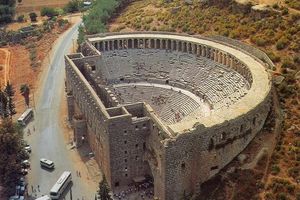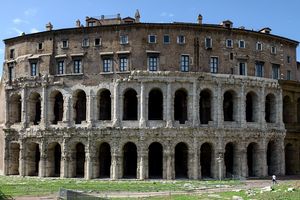Theater
Modern theater buildings inevitably bring us back to the era of antiquity, where these types of structures originated. It is indisputable that theaters were entirely a Greek invention, and their popularity in Rome came from there. However, it should be noted that this was not a blind copying by Roman architects.
Roman theaters had several fundamental differences from their Greek predecessors. According to Vitruvius, Roman and Greek theaters follow different construction rules. The ancient author describes the plan of the Roman theater as follows: "Having marked the central point, one should draw a line of circumference corresponding in size to the perimeter of the future lower area, and inscribe four equilateral triangles in this circumference, touching its extreme line at equal intervals. The side of one of these triangles, closest to the stage, will determine the boundary of its front side by a line cutting off a segment of the circle; then, one must draw through the center a line parallel to this, which will separate the proscenium platform from the orchestra space." Vitruvius writes, "In Greek theaters, architects enclose in the main circle not four triangles, but three squares, their corners touching the line of the circumference; the side of one of the squares, nearest to the stage and cutting off a segment of the circle, determines this boundary by a line. Parallel to this direction, a line is drawn, tangent to the extreme part of the circumference, and at the ends of the semicircle, central points are marked. Placing the compass on the left point, they draw an arc, starting from the left interval to the left part of the proscenium; and in the same way, transferring the center to the extreme left point, they draw an arc from the right interval to the right part of the proscenium." These differences are related to the fact that the Romans needed a wider platform and a narrower orchestra. The reason is that in the Roman theater, all actors performed on the stage, and the orchestra was intended for the seats of senators and magistrates, whereas in Greece, tragic and comic actors performed on the stage, while others performed in the orchestra.
The main difference between Greek and Roman theaters is that the Roman theater was a standalone building. In the "Universal History of Art," the authors state that the Roman theater was an independent structure, not carved into a hillside like Greek theaters; another feature was the presence of a stage building, while in the Greek theater of the classical era, the real landscape unfolded behind the stage platform. Thus, the internal space of the Roman theater was enclosed and isolated; the Greek theater was organically connected with nature, while the Roman theater was more of an urban structure ("Universal History of Art. Vol. 1. The Art of the Ancient World"). The fact that Roman theaters were standalone buildings is also seen in the work of I. Cole. The researcher writes that Roman theaters were semicircular in shape and had a stage, rather than being open on the front side to the surrounding landscape (Cole E. "A Concise History of Architectural Styles"). The Roman theater used a system of vaulted galleries—substructions. These were used as foyers, allowing the theater to be quickly filled and emptied of spectators. There were also evacuation corridors located under the seating areas. Ancient Greek architects, like Roman ones, had the same task when building theaters—to ensure that sounds from the stage reached the audience. Vitruvius writes: "For this reason, the ancient architects, following nature's lead, built the steps of theaters based on the ascending voice, and through mathematical canons and the theory of music, tried to make every sound from the stage reach the listeners' ears more clearly and pleasantly."
It is important to note that wooden theaters existed in both Greece and Rome. Mentions of one of them can be found in Pliny the Elder, namely the Roman wooden theater of the consul of 115 BC, Marcus Aemilius Scaurus. "During his aedileship," wrote Pliny the Elder, "Marcus Scaurus created a structure, the greatest of all that have ever been created by human hand, not only short-lived but even designed to last forever. This was a theater. The stage was divided into three levels, with 360 columns—and this in a state that could not tolerate six Hymettian columns without condemning an outstanding citizen. The lower part of the stage was made of marble, the middle part of glass (such luxury was unheard of even afterward), and the upper part of gilded boards. The lower columns were, as we said, thirty-eight feet high" (Pliny the Elder, "Natural History. On Art.," translated by G. A. Taroyan). Wooden theaters have not survived to our time. There was a practice of building stone theaters on the site of destroyed wooden ones.
Now we will consider two Roman theaters. Both are made of stone.
The construction of the first stone theater in Rome—the Theater of Pompey—dates back to 55-50 BC. It should be noted that this was not just a theater, but an entire theatrical complex, which included a temple, the theater itself, porticos adjoining the stage—all surrounded by a garden. The total area of the complex was 1.5-2 hectares. The seating was arranged in three concentric tiers. According to P. Giro, the spectator seats and all the interior decorations were made of marble. Significant parts of these structures have been preserved, currently located under modern buildings. This theater burned several times under Augustus, Tiberius, Titus, Philip the Arab, Diocletian—and was each time restored, so that performances were still held in it as late as the 6th century. Behind the stage was a large portico surrounding an area planted with sycamores and adorned with fountains, marble, and gilded bronze statues (Giro P. "Private and Public Life of the Romans"). Nearby, several statues and columns made of red Egyptian granite were discovered.
The construction of the Theater of Marcellus in Rome was started by Caesar and completed in 13 BC under Octavian Augustus. The building was named in honor of Augustus's late nephew, Marcus Claudius Marcellus, and could accommodate 10-14 thousand people. This structure was executed in the Roman-Italic style: the building was a completely independent structure, not integrated into the landscape like, for example, the Theater of Dionysus in Athens. From the very beginning of construction, there was an evacuation system through substructions. The final part of the evacuation was a lower corridor running around the entire theater and open to the outside through a series of arches. The Theater of Marcellus has survived to this day in a greatly altered form. The reason is that the theater building was constantly dismantled by local residents for stones throughout late antiquity and the early Middle Ages. Later, as stated in the "Universal History of Architecture," by the 12th century, the theater was converted into a fortress, and during the Renaissance, the former theater became the property of the Orsini family, who, with the help of the architect Peruzzi, converted it into a palace. Today, the theater is a two-story building with 16 arched axes, 4 of which have been restored. The lower arcade of the theater is in the Doric order, while the upper one is in the Ionic order. This multi-tiered arcade became the main compositional technique of subsequent amphitheaters and theaters ("Universal History of Architecture. Vol. 2. Architecture of Ancient Rome"). This structure is a striking example of Roman architecture.
Related topics
Architecture in Ancient Rome, Ancient Rome
Literature
1) Velizh'skii F. F. Byt grekov i rimlyane [Life of the Greeks and Romans]. edited by I. Ya. Rostovtsev. Prague: I. Militky and Novak, 1878.
2) Vitruvius. Ten books about Architecture / translated from Latin by F. A. Petrovsky, Moscow: Librocom, 2012.
3) Universal History of Architecture, vol. 2. Architecture of ancient Rome, 1948.
4) Universal History of Arts, vol. 1.Iskusstvo drevnego mira [Art of the ancient World]. 1956.
5) Giro P. Chastnaya i obshchestvennaya zhizn rimlyane [Private and public life of the Romans]. St. Petersburg: Aletheia Publ., 1995.
6) Pliny the Elder. Natural science. About art. Translated by G. A. Taroyan, Moscow: Ladomir Publ., 1994.
7) Cole E. A Concise history of architectural styles. L.: A & C Black, 2003.




